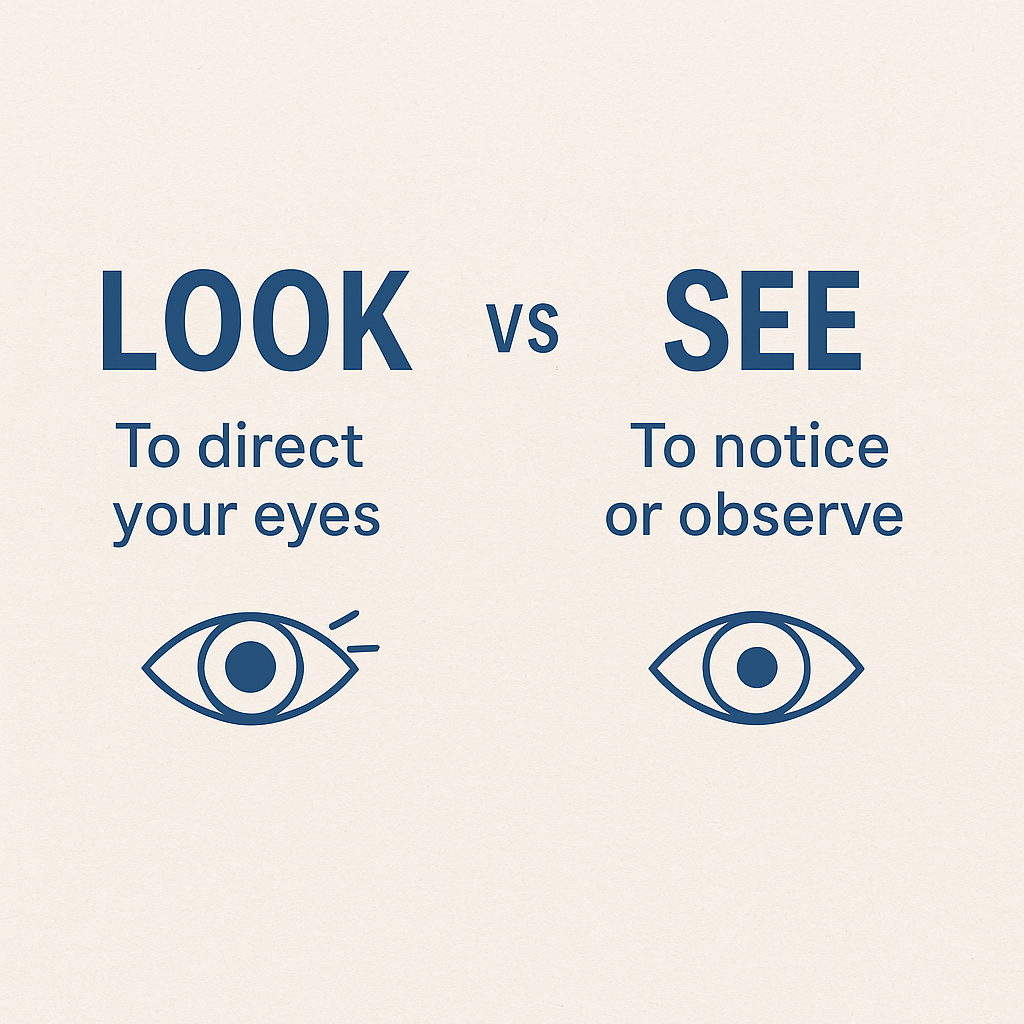Look vs See

“Look” vs “see” are two simple English verbs we use almost daily, but they’re often mixed up. Why? Because both are related to the act of using our eyes. However, there’s a key difference in intention and awareness.
See refers to the passive act of perceiving something with your eyes often unintentionally.
Look means to intentionally direct your eyes at something.
This might sound subtle, but using the wrong one can shift the clarity or tone of your message. For example:
I looked at the painting.
I saw the painting.
The first implies focus, the second implies awareness.
In this article, we’ll break down “look vs see” grammatically, offer practical examples, highlight common misuses, and give memory tips to keep your usage sharp and correct.
Grammatical Explanation of Look vs See
- See is an intransitive verb (it doesn’t require a direct object) and refers to the ability to perceive something visually. It often describes involuntary or passive observation.
Examples:
I can see the mountain from here.
Did you see that bird?
- Look is a transitive verb (usually followed by at) and requires an intention or direction. It means to direct your vision toward something with focus or purpose.
Examples:
✅ Look at the sky, it’s beautiful.
✅ He looked at me angrily.
Another variation:
- See focuses on perception.
- Look emphasizes effort or action.
You see without trying. You look with effort.
This difference makes one more active (look) and the other more passive (see), which is key to mastering their use.
Real-Life Examples of Look vs See
Here’s how “look vs see” appear in real-life contexts:
✅ See:
- I saw lightning last night.
- She sees everything from her office window.
- Did you see my message?
✅ Look:
- Look at this photo from my trip!
- He looked at his watch and sighed.
- Please look both ways before crossing the street.
Incorrect usage:
- I was looking the sunset.
I was looking at the sunset. - He looked a bird flying by.
He saw a bird flying by.
Pro tip:
If you notice something without trying, it’s see.
If you actively focus your attention, it’s look.
Think of it like this:
👁️ See = “vision happens.”
👀 Look = “you make it happen.”
Common Mistakes
Many people confuse “look” and “see” because they both involve the eyes, but here are some common mistakes to avoid:
I was seeing the stars.
I was looking at the stars. (Because you were focusing on them)
Did you look that movie?
Did you see that movie?
❌ She saw at me angrily.
✅ She looked at me angrily.
To get this right, ask yourself:
- Was it intentional and focused? Use look.
- Was it passive and automatic? Use see.
Remember: “See” doesn’t need at, “look” does.
Memory Tips
Try these memory tricks to never mix them up again:
🔹 See = Spontaneous
You don’t plan it; it just happens.
- Think: “I see the sun, it’s bright!”
🔹 Look = Longing, Listening, or Locating
You’re trying to observe something on purpose.
- Think: “Look at the stars and make a wish.”
Mnemonic:
“I see by chance. I look by choice.”
or
“Look = Locate.” You try to locate something visually.
Still confused? Think about body movement:
- To look, you often move your head or eyes.
- To see, your eyes simply notice.
Want more grammar clarity? Check out our guide on Hear vs Listen.
For further reading on visual verbs, see this helpful article from Cambridge Dictionary.
Conclusion
Understanding the difference between “look” and “see” can greatly improve your clarity in English. Use see when referring to passive visual perception, and use look when describing intentional, focused vision.
Still unsure? Just ask: “Did I try to see it?” If yes, go with look.
Want more word comparisons? Check out our deep dives on “Hear vs Listen” or “Too vs To” to continue improving your vocabulary.